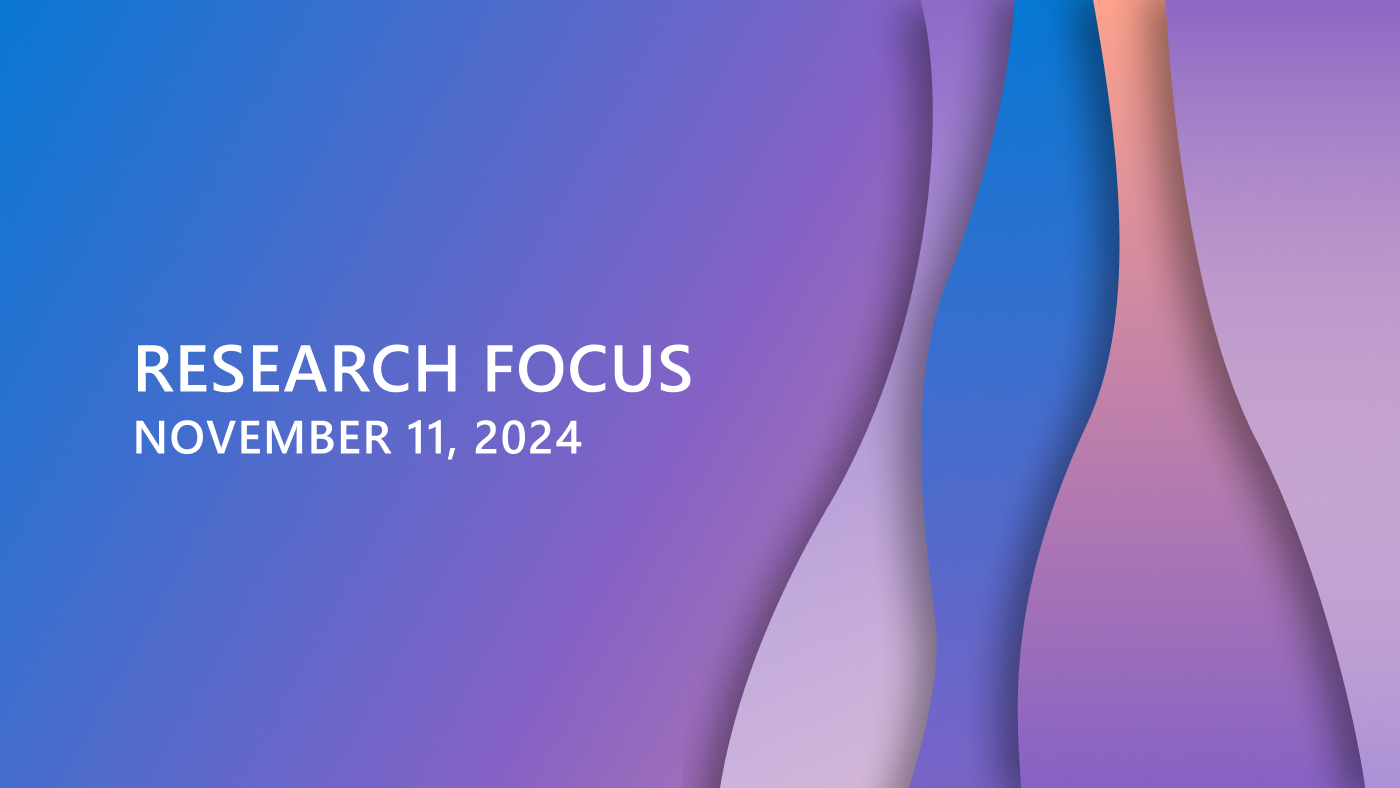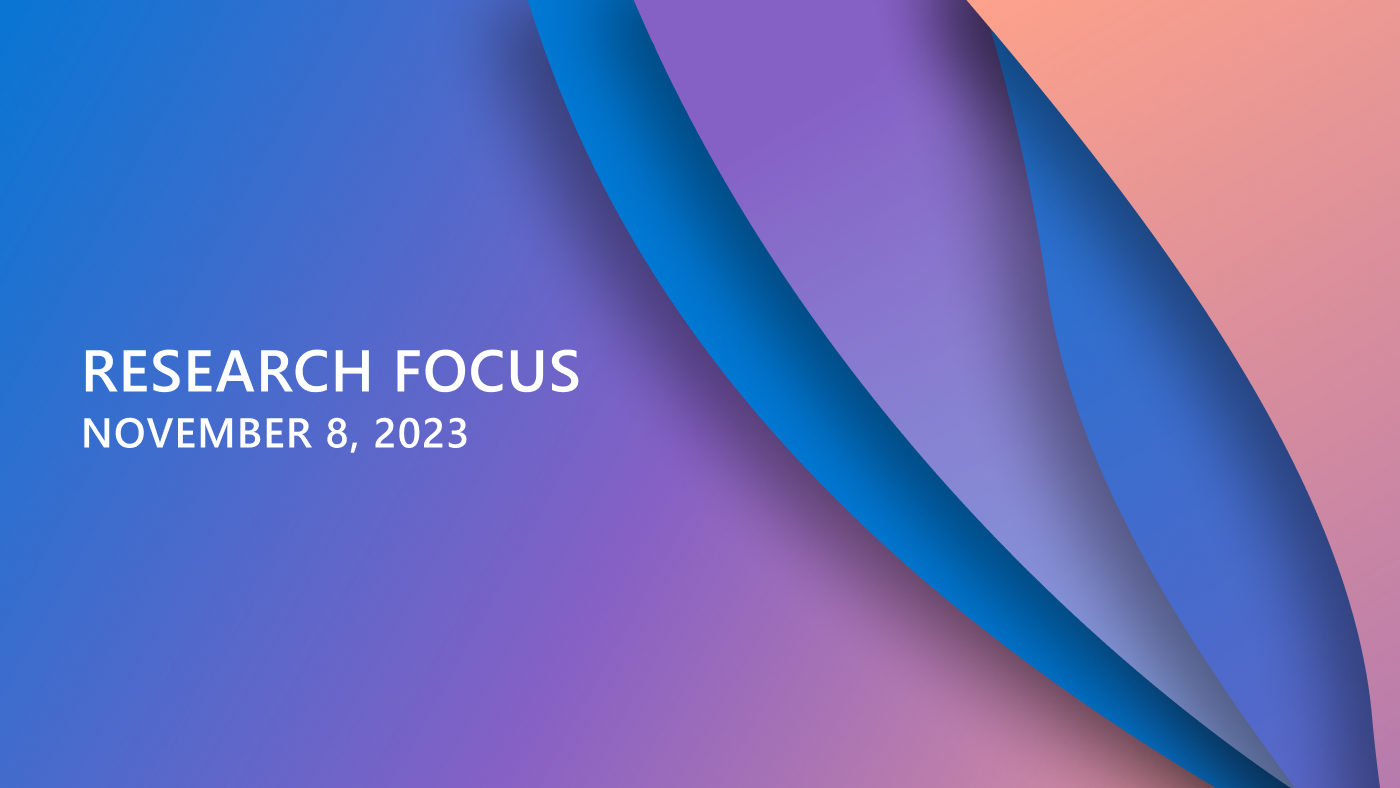
Welcome to Research Focus, a new series of blog posts that highlights notable publications, events, code/datasets, new hires and other milestones from across the research community at Microsoft.
Microsoft Research at NeurIPS 2022
- Event NeurIPS 2022
Microsoft is a proud platinum sponsor of the 36th annual conference on Neural Information Processing Systems (opens in new tab), running from November 28 to December 9. More than 150 of our researchers are involved in presentations, poster sessions, accepted papers, and workshops at this prestigious conference.
We are thrilled to have had more than 100 papers accepted at NeurIPS 2022. Our full roster includes cutting edge research ranging from differential privacy and reinforcement learning to extreme compression, motion capture and large language models.
This hybrid conference includes an in-person component at the New Orleans Convention Center during the first week, and a virtual component the second week. Check out our list of sessions and plan your schedule.
If you will be attending in person, we hope you will stop by our booth (#202) to chat with our experts, see demos of our latest research and find out about career opportunities with Microsoft.
Spotlight: Blog post
Eureka: Evaluating and understanding progress in AI
How can we rigorously evaluate and understand state-of-the-art progress in AI? Eureka is an open-source framework for standardizing evaluations of large foundation models, beyond single-score reporting and rankings. Learn more about the extended findings.
Project Eclipse shows neighborhood level air pollution inequities in real time and during short-term air quality events
Precious Esie, Madeleine I. G. Daepp, Asta Roseway, and Scott Counts
Air pollution kills over 7 million people globally every year (opens in new tab). In U.S. cities, pollution sources are more likely to affect communities of color – but the most impacted communities rarely have the data they need to understand and address this invisible hazard.
-
 Project
Project Eclipse
Project
Project Eclipse
Through Project Eclipse, a team from Microsoft Research has worked with the Chicago Department of Public Health and JCDecaux – an advertising agency and the world’s largest provider of outdoor street furniture – to deploy low-cost air quality sensors across the city’s bus shelters. In a new paper published this week in the American Journal of Public Health, the team showed how the citywide network of sensors enabled them to capture and visualize differences in exposures over time and space. The work was led by Precious Esie, a PhD student in epidemiology at Columbia’s Mailman School of Public Health, during her summer internship at Microsoft Research.
Over the month of July 2021, the research team found, pollution disproportionately affected Hispanic and Latinx residents on the West side of the city. But 4th of July spikes disproportionately affected the South side—including places where asthma rates are highest. In late July, wildfire smoke increased exposures across the city as a whole. This work shows how next-generation environmental sensing can help public health agencies target interventions when and where they are most needed.
Microsoft Research contributes to industry supply chain standards
Kiran Karunakaran, Principal Product Manager, Azure Security Engineering
Supply Chain Integrity, Transparency and Trust (SCITT) is an industry-standards initiative for managing the compliance of goods and services across end-to-end supply chains, allowing organizations to build, deploy and consume interoperable and automated solutions to manage end-to-end supply chain compliance. SCITT (opens in new tab) was initiated as a response to United States Executive Order on Improving the Nation’s Cybersecurity (EO14028 (opens in new tab)), and was formally adopted into the Internet Engineering Task Force (opens in new tab) (IETF) in March 2022. Over the last eight months, SCITT has been one of the fastest growing initiatives within IETF and became a formal working group in October 2022.
Microsoft Research is actively contributing to IETF SCITT Architecture (opens in new tab) and SCITT Receipt Format (opens in new tab) Internet Drafts and will be providing and collaborating on several SCITT-related open-source software offerings. This includes the donation of a SCITT Emulator (opens in new tab) that allows SCITT implementers to experiment with SCITT APIs and message formats. Microsoft is also open sourcing our SCITT implementation prototype (opens in new tab) that runs on Confidential Consortium Framework (microsoft.com) (opens in new tab), providing visibility into one of the many possible implementations of SCITT.
A SCITT IETF Working Group session (opens in new tab) was held at IETF115 on Nov 10th. To learn more about the community efforts, blogs, and implementations around SCITT, please visit SCITT.io (opens in new tab).
- DOWNLOAD SCITT API emulator
- DOWNLOAD SCITT implementation prototype
2010 paper lands “Test of Time” award for Microsoft researcher Mike Chieh-Jan Liang and co-authors
Mike Chieh-Jan Liang, a principal researcher in the Systems and Networking Research Group (Asia), is part of a team that won a “Test of Time” award for the 2010 paper: Design and Evaluation of a Versatile and Efficient Receiver-Initiated Link Layer for Low-Power Wireless.
The research introduced A-MAC, a receiver-initiated link layer for low-power wireless networks that supported several services under a unified architecture, and more efficiently and scalably than prior approaches.
Co-authors on the paper include Prabal Dutta (University of Michigan), Stephen Dawson-Haggerty (University of California, Berkeley), Yin Chen (Johns Hopkins University), and Andreas Terzis (Johns Hopkins University).
The Test of Time award is given by ACM SenSys in recognition of papers that are at least 10 years old and have had long lasting impact on networked embedded sensing system science and engineering.





